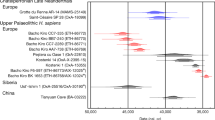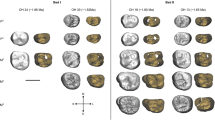Abstract
The appearance of anatomically modern humans in Europe and the nature of the transition from the Middle to Upper Palaeolithic are matters of intense debate. Most researchers accept that before the arrival of anatomically modern humans, Neanderthals had adopted several ‘transitional’ technocomplexes. Two of these, the Uluzzian of southern Europe and the Châtelperronian of western Europe, are key to current interpretations regarding the timing of arrival of anatomically modern humans in the region and their potential interaction with Neanderthal populations. They are also central to current debates regarding the cognitive abilities of Neanderthals and the reasons behind their extinction1,2,3,4,5,6. However, the actual fossil evidence associated with these assemblages is scant and fragmentary7,8,9,10, and recent work has questioned the attribution of the Châtelperronian to Neanderthals on the basis of taphonomic mixing and lithic analysis11,12. Here we reanalyse the deciduous molars from the Grotta del Cavallo (southern Italy), associated with the Uluzzian and originally classified as Neanderthal13,14. Using two independent morphometric methods based on microtomographic data, we show that the Cavallo specimens can be attributed to anatomically modern humans. The secure context of the teeth provides crucial evidence that the makers of the Uluzzian technocomplex were therefore not Neanderthals. In addition, new chronometric data for the Uluzzian layers of Grotta del Cavallo obtained from associated shell beads and included within a Bayesian age model show that the teeth must date to ∼45,000–43,000 calendar years before present. The Cavallo human remains are therefore the oldest known European anatomically modern humans, confirming a rapid dispersal of modern humans across the continent before the Aurignacian and the disappearance of Neanderthals.
This is a preview of subscription content, access via your institution
Access options
Subscribe to this journal
Receive 51 print issues and online access
$199.00 per year
only $3.90 per issue
Buy this article
- Purchase on Springer Link
- Instant access to full article PDF
Prices may be subject to local taxes which are calculated during checkout



Similar content being viewed by others
References
d’Errico, F., Zilhão, J., Julien, M., Baffier, D. & Pélegrin, J. Neanderthal acculturation in Western Europe? A critical review of the evidence and its interpretation. Curr. Anthropol. 39, 1–44 (1998)
Gravina, B., Mellars, P. & Ramsey, C. B. Radiocarbon dating of interstratified Neanderthal and early modern human occupations at the Châtelperronian type-site. Nature 438, 51–56 (2005)
Mellars, P., Gravina, B. & Bronk Ramsey, C. Confirmation of Neanderthal/modern human interstratification at the Châtelperronian type-site. Proc. Natl Acad. Sci. USA 104, 3657–3662 (2006)
Zilhão, J. et al. Analysis of Aurignacian interstratification at the Châtelperronian-type site and implications for the behavioral modernity of Neandertals. Proc. Natl Acad. Sci. USA 103, 12643–12648 (2006)
Ronchitelli, A., Boscato, P. & Gambassini, P. in La lunga storia di Neandertal. Biologia e comportamento (eds Facchini, F. & Belcastro, G. M. ) (Jaca Book, 2009)
d’Errico, F., Borgia, V. & Ronchitelli, A. Uluzzian bone technology and its implications for the origin of behavioural modernity. Quat. Int.. 10.1016/j.quaint.2011.03.039 (in the press)
Lévêque, F. & Vandermeersch, B. M. Découverte de restes humains dans un niveau castelperronien à Saint-Césaire (Charente-Maritime). CR Acad. Sci. Paris 291, 187–189 (1980)
Hublin, J. J., Spoor, F., Braun, M., Zonneveld, F. & Condemi, S. A late Neanderthal associated with Upper Palaeolithic artefacts. Nature 381, 224–226 (1996)
Harvati, K., Panagopoulou, E. & Karkanas, P. First Neanderthal remains from Greece: the evidence from Lakonis. J. Hum. Evol. 45, 465–473 (2003)
Bailey, S. E. & Hublin, J. J. Dental remains from the Grotte du Renne at Arcy-sur-Cure (Yonne). J. Hum. Evol. 50, 485–508 (2006)
Bar-Yosef, O. & Bordes, J. G. Who were the makers of the Châtelperronian culture? J. Hum. Evol. 59, 586–593 (2010)
Higham, T. et al. Chronology of the Grotte du Renne (France) and implications for the context of ornaments and human remains within the Châtelperronian. Proc. Natl Acad. Sci. USA 107, 20234–20239 (2010)
Palma di Cesnola, A. & Messeri, M. P. Quatre dents humaines paléolithiques trouvées dans des cavernes de l’Italie Méridionale. L’Anthropologie 71, 249–262 (1967)
Churchill, S. E. & Smith, F. H. Makers of the early Aurignacian of Europe. Am. J. Phys. Anthropol. 113 (Suppl. 31). 61–115 (2000)
Palma di Cesnola, A. L’Uluzzien: faciès italien du leptolithique archaique. L’Anthropologie 93, 783–812 (1989)
Riel-Salvatore, J. in Sourcebook of Paleolithic Transitions (eds Camps, M. & Chauhan, P. ) (Springer, 2009)
Messeri, P. & Palma di Cesnola, A. Contemporaneità di paleantropi e fanerantropi sulle coste dell'talia meridionale. Zephyrus 26–27, 7–30 (1976)
Benazzi, S. et al. Comparison of dental measurement systems for taxonomic assignment of first molars. Am. J. Phys. Anthropol. 144, 342–354 (2011)
Olejniczak, A. J. et al. Dental tissue proportions and enamel thickness in Neandertal and modern human molars. J. Hum. Evol. 55, 12–23 (2008)
Smith, B. H. Patterns of molar wear in hunter-gatherers and agriculturists. Am. J. Phys. Anthropol. 63, 39–56 (1984)
Reimer, P. J. et al. IntCal09 and Marine09 radiocarbon age calibration curves, 0–50,000 years cal BP. Radiocarbon 51, 1111–1150 (2009)
Boscato, P. & Crezzini, J. Middle-Upper Palaeolithic transition in Southern Italy: Uluzzian macromammals from Grotta del Cavallo (Apulia). Quat. Int.. 10.1016/j.quaint.2011.03.028 (in the press)
Müller, U. C. et al. The role of climate in the spread of modern humans into Europe. Quat. Sci. Rev. 30, 273–279 (2011)
Higham, T. European Middle and Upper Palaeolithic radiocarbon dates are often older than they look: problems with previous dates and some remedies. Antiquity 85, 235–249 (2011)
Pinhasi, R., Higham, T. F., Golovanova, L. V. & Doronichev, V. B. Revised age of late Neanderthal occupation and the end of the Middle Paleolithic in the northern Caucasus. Proc. Natl Acad. Sci. USA 108, 8611–8616 (2011)
Zilhão, J. in Continuity and Discontinuity in the Peopling of Europe (eds Condemi, S. & Weniger, G. C. ) (Springer, 2011)
Mellars, P. The impossible coincidence: a single species model for the origins of modern human behavior in Europe. Evol. Anthropol. 14, 12–27 (2005)
Martin, L. B. Significance of enamel thickness in hominoid evolution. Nature 314, 260–263 (1985)
R Development Core Team . R: a language and environment for statistical computing. 〈http://www.r-project.org〉 (2008)
Rohlf, F. J. & Slice, D. E. Extensions of the Procrustes method for the optimal superimposition of landmarks. Syst. Zool. 39, 40–59 (1990)
Acknowledgements
We thank the Soprintendenza per i Beni Archeologici della Puglia which facilitated the excavation of Grotta del Cavallo over the years. We also thank M. A. Gorgoglione who supported and helped in the collection of samples for 14C dating and encouraged the collaboration with the University of Siena for the study of the archaeological remains. P. Boscato, H. Klempererova, F. Ranaldo and S. Ricci have all helped in aspects of the research and are especially thanked. We are grateful to G. Gruppioni for providing the Italian modern human sample used in this work. We thank M. Francken, B. Trautmann, I. Trautmann, H. Scherf, M. Dockner and R. Ginner for technical assistance. We thank F. L. Bookstein for suggestions on statistics. Access to the fossil specimens was made possible by the Croatian National History Museum, the French Musée National de Préhistoire, the French Muséum National d’Histoire Naturelle, Paleoanthropology, Eberhard Karls Universität Tübingen and the NESPOS Database 2011 (https://www.nespos.org/display/openspace/Home). We acknowledge the Centre de Microtomographie (Université de Poitiers), the Vienna micro-CT Laboratory (University of Vienna), VISCOM AG Hannover, the Paleoanthropology High Resolution Computing Tomography Laboratory (Eberhard Karls Universität Tübingen), the European Synchrotron Radiation Facility beamline ID17, the AST-RX platform (French Muséum National d’Histoire Naturelle) and the Oxford Radiocarbon Accelerator Unit (ORAU). The authors would like to thank T. Higham and R. E. M. Hedges for their input in the radiocarbon dating part of the project, for important comments and proofreading this manuscript. The radiocarbon dating was funded by the Natural Environment Research Council (NERC) NRCF programme. K.D. is part of the Ancient Human Occupation of Britain project, funded by the Leverhulme Trust. This work was supported by the NSF 01-120 Hominid Grant 2007, A.E.R.S. Dental Medicine Organisations GmbH FA547013, the Fondation Fyssen, the DFG INST 37/706-1 FUGG and the NERC Grant (NE/D014077/1).
Author information
Authors and Affiliations
Contributions
S.B., F.M., K.H. and G.W.W. initiated and organized the project. S.B., C.C.B., P.B., J.S., I.P., K.H. and G.W.W. collected the fossils and modern human sample. S.B. and C.F. carried out the dental measurements. S.B. and M.C. analysed the data. K.D. initiated and performed the radiocarbon dating project. S.B., K.D., C.F., O.K., M.C., S.C., A.R., K.H. and G.W.W. discussed the results. S.B., K.D., C.F., M.C., S.C., A.R., K.H. and G.W.W. wrote and edited the manuscript.
Corresponding author
Ethics declarations
Competing interests
The authors declare no competing financial interests.
Supplementary information
Supplementary Information
The file contains Supplementary Methods and Results, Supplementary Figures 1-5 with legends, Supplementary Tables 1-6 and additional references. (PDF 651 kb)
Rights and permissions
About this article
Cite this article
Benazzi, S., Douka, K., Fornai, C. et al. Early dispersal of modern humans in Europe and implications for Neanderthal behaviour. Nature 479, 525–528 (2011). https://doi.org/10.1038/nature10617
Received:
Accepted:
Published:
Issue Date:
DOI: https://doi.org/10.1038/nature10617
This article is cited by
-
Shear margins in upper half of Northeast Greenland Ice Stream were established two millennia ago
Nature Communications (2024)
-
Us and Them: How to Reconcile Archaeological and Biological Data at the Middle-to-Upper Palaeolithic Transition in Europe?
Journal of Paleolithic Archaeology (2024)
-
High-resolution ecosystem changes pacing the millennial climate variability at the Middle to Upper Palaeolithic transition in NE-Italy
Scientific Reports (2023)
-
Subsistence of early anatomically modern humans in Europe as evidenced in the Protoaurignacian occupations of Fumane Cave, Italy
Scientific Reports (2023)
-
The Middle Paleolithic of the Balkans: Industrial Variability, Human Biogeography, and Neanderthal Demise
Journal of World Prehistory (2023)
Comments
By submitting a comment you agree to abide by our Terms and Community Guidelines. If you find something abusive or that does not comply with our terms or guidelines please flag it as inappropriate.



